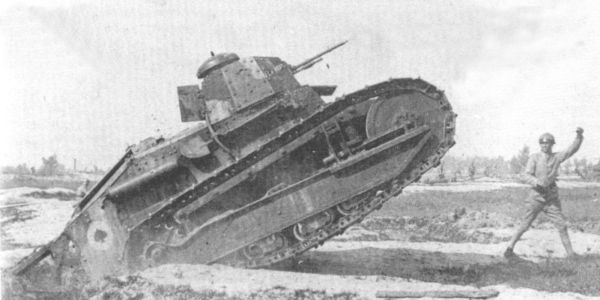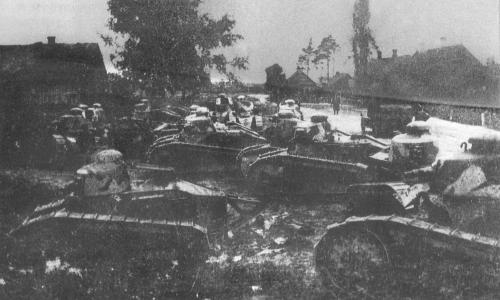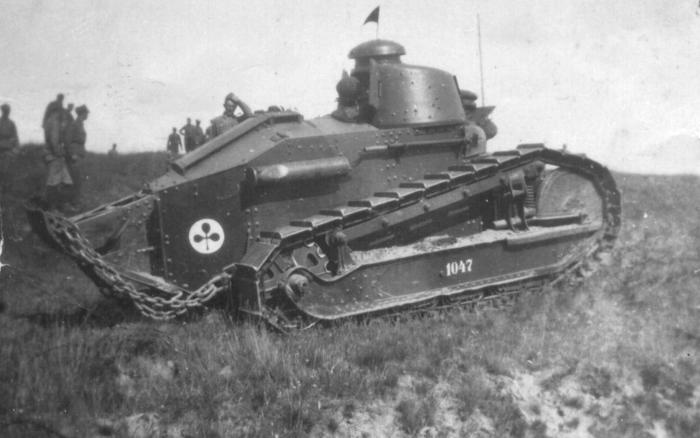| Main page – Polish armour » tanks » Renault FT – Polish artillery – Steel Panthers – what's new |  | ||
| © Michal Derela, 2002 | Updated: 16. 12. 2024 | ||
| Main page – Polish armour » tanks » Renault FT – Polish artillery – Steel Panthers – what's new |  | ||
| © Michal Derela, 2002 | Updated: 16. 12. 2024 | ||
The French light infantry tank Renault FT-17 (Renault FT M1917) was probably the most revolutionary tank design in the history. It was the first tank with an armament in a rotating turret, and its composition became the classic one. The prototype was constructed in 1917, and more than 3800 were produced. The tank was widely used in the battles of the First World War since 31 May 1918. After World War I they were exported to many countries. These tanks were used by most countries, which possesed armoured forces in interwar period, usually as their first tank type. Most of the produced tanks were still in service at the outbreak of World War II, although they were completely obsolete by then. This page is devoted to the Polish service of FT-17 tanks only.
 |
| The Polish FT-17 in the 1920s. |
The 1st Tank Regiment was equipped with 120 tanks FT-17: 75 armed with a 37mm gun Puteaux SA-18 L/21, and 45 armed with a 8mm Hotchkiss Mle.14 MG (the other source states 72 and 48 respectively). The regiment consisted of 5 companies, divided between 2 battalions. Each company had 3 tank platoons. One platoon consisted of 5 tanks: 3 gun-armed, including a commander's tank, and 2 MG-armed ones.
 |
| A Polish FT-17 company arrived in the front area, 1919. The first tank is MG-armed, next three gun-armed. [2] |
 |
| Polish FT-17's of the 2nd company at Dyneburg. Click to enlarge [source - 5] |
Since August 1919, the Polish FT-17s were used in the Polish-Soviet war. Among others, the tanks of the 2nd company, commanded by the French Cpt. J. Dufour, fought in a battle of Dyneburg town on 27-28. 09. 1919 (now: Daugavpils, Latvia). By 1920 most of the French personnel departed back to France. In July 1920, FT-17 tanks were used in retreat combat, in defence of Lida, Grodno and Rowne. Then, they took part in the great Warsaw Battle in August 1920 (in a combat around Radzymin, and in attack of Maj. Nowicki's armoured group on Minsk Mazowiecki and Mlawa). At that time, some damaged tanks were put on railway flatcars and used as parts of armoured trains. During the war 1919-1920, 8 tanks were destroyed, 12 were damaged and later repaired.
In 1924, 6 radio command tanks Renault TSF were bought in France. They were based upon FT-17 hull, fitted with a radio in a big superstructure in a place of a turret. They were not armed. Also, in 1929-1930, some of newer Renault tank designs were bought. They were 5 tanks Renault M26/27 and 1 tank Renault NC-27 (publications often quote 24 tanks NC-27[1], but only one was bought in fact). M26/27 was an unsucesfull development of FT-17, with the same hull and armament, fitted with a new track mechanism with Kegresse rubber tracks (they were proposed to the French Army under the desigantion NC-2). Renault NC-27 was a further development of FT-17, with a redesigned hull, new chassis and a turret armed with a coaxial 37mm gun SA-18 and MG (they were proposed to the French Army under the designation NC-1; its further development led to the French D1 tank).
 By 1925, Cpt. S. Kardaszewicz developed new small-link tracks for FT-17 tanks. Usage of small-link tracks increased speed, improved fuel consumption, and lowered noise and shock level. At least 65 tanks were fitted with the new tracks since 1926 (it is not known how many tanks used these tracks in 1939).
By 1925, Cpt. S. Kardaszewicz developed new small-link tracks for FT-17 tanks. Usage of small-link tracks increased speed, improved fuel consumption, and lowered noise and shock level. At least 65 tanks were fitted with the new tracks since 1926 (it is not known how many tanks used these tracks in 1939).
In 1926, a series of 27 tanks FT-17 were built in the Polish works CWS in Warsaw (Centralne Warsztaty Samochodowe - Central Car Workshops). They were completed utilizing original spare parts, and regular steel plates. Because of it, they had almost no armour protection, and were called "iron tanks". They were used mostly for crew training.
| On the right: a Polish-built Renault FT-17 CWS with small-link tracks. A badge "CWS" is visible on a front plate. Next to a gun is a telescopic sight. [source: 1,4] |

An unusually-looking Polish modification developed and tested in 1926, was FT-17 with a smokescreen generator (called: a "gas tank"). It had two long cylinders with chemicals. The project was rejected, but the photos of this tank remained popular in the Polish and foreign military press for a long time (sugesting it was a chemical warfare tank). [photo on the right - source 2].
In 1933 there was developed a special rail chassis for FT-17 tank, to use it as an armoured rail vehicle. Such tanks on the rail chassis were designated: armoured draisine R. See more on armoured draisines page.
In the thirties, the obsolete radio tanks TSF were scheduled to be rebuild to combat tanks, replacing the superstructure with a turret. A new turret with a coxial 37mm gun and MG was developed by the Polish in this purpose, but it is not clear, if these tanks were eventually rebuilt using these turrets (it is rather doubtful, as no photos are known). There were also tested some modernization projects of regular FT-17 tanks, including changes in hull shape and engine cooling system (FT-17 "Hanus"), suspension (from Vickers E tank) and new turrets, mentioned above, but none were accepted.
In 1930-36, the Polish Army had the biggest number of its Renault tanks:
 |
| Polish FT-17 on manoeuvres in the 20's. Photo courtesy by Zbigniew Cheda. |
A number of the Polish FT-17s is not clear. The data above is taken from [1], with the exception, that there was only 1 tank NC-27. In other sources, a number of 174 is often quoted as a number of FT-17 tanks only. Despite tanks M-26/27 and NC-27 were different designs, they were counted in a global number of Renault FT tanks, and were not distinguished in official reports[1]. Therefore, their later fate is not known.
In 1936-37, one company of 16 (or 15) tanks was sold fictitiously to Uruguay, in fact to Republican Spain. Further 2 or 3 companies were sold to China (according to some sources[2], they went to Spain in fact as well. Some sources state, that from 64 to 90 tanks were sold to Spain - the latter number is improbable, considering the number of the Polish tanks left). Reportedly, some Renault FT-17 CWS were sold among others, despite their questionable combat worthiness.
Before the war, in 1939, the Polish Army still had 102 light tanks FT-17, of those 70 in the 2nd armoured battalion in Żurawica and 32 in two Armoured Trains' Units (as armoured draisines). Some of these tanks were "iron" FT-17 CWS.
The combat usefulness of FT-17 tanks in 1939 was very limited, since they were very obsolete and extremely slow by these standards. In September 1939, the 2nd armoured battalion formed three light tank companies (numbers: 111, 112, 113), equipped with Renault FT-17 tanks. Their mobilization was finnished on 6 September 1939, and then they were transported towards Brzesc on the Bug. Due to bombarding of the track, the 111th light tank company was unloaded near Łuków town on 9 September. In the next few days the company was trying to withdraw to the east, suffering from lack of fuel and lack of contact with friendly units (two tanks were destroyed by a reconnaissance unit of "Kempf" Panzer Division). The details about 111th company's track are not known, but the remaining tanks were captured on 16 September.
The 112th and 113th light tank companies arrived at Brzesc upon the Bug fortress (now: Brest, Belarus). They were deployed in defensive positions there, expecting an attack. The German 10th Panzer Division attacked Brzesc on 14 September. 12 tanks FT-17 of the 113th company, deployed in allotment gardens to the north of the Citadel in Brzesc, were destroyed fighting against German II battalion of the 8th tank regiment. There is no information about the German losses. The enemy tanks, however, did not manage to cross the northern Citadel gate, which was blocked by the tanks of the 112th company. On 15 September the enemy assaults on the Citadel were repelled, with a help of the 112th company's tanks, which were firing from covered positions within the fortress. On 16 September, after all-day combat, the Polish units abandoned the citadel. A breakthrough trial of the remaining tanks failed, so they were left.
 | Well-known photo of the German soldiers examining Polish FT-17 tanks in the northern gate of the Citadel in Brzesc. According to most sources, the German tanks, attacking on 14 September 1939, did not manage to cross the Citadel main gate, blocked by the FT-17 tanks of 112. company. [2,3,4] |
More useful were FT-17 tanks acting as armoured draisines of armoured trains. They were used mainly for track reconnaissance. In some cases, they were used on the ground, supporting infantry or tankettes with fire. Each armoured train (apart from train nr. 15) had two such draisines - totally 18 tanks FT-17 were used this way. All were armed with guns.
Just before the outbreak of the war, two tanks FT-17 of train nr.13 were given to the Army Pomorze to strengthen the defense of the bridge in Tczew. They did not see action there, however, and their fate is not known. The train nr.13 supposedly was given the other two tanks FT-17 (draisines R).

Apart from these mobilized units, FT-17 tanks were also used in some improvised units. Most probably these tanks of the former 2nd battalion were in the independent light tank company, created in Brzesc as a unit of the C-in-C disposal[3]. It left the town towards Wlodzimierz Wolynski on 14 September, and in the next days lost several tanks in combat with the enemy armoured units.
| An unique photo of the Polish Renault FT-17, with small-link tracks, abandoned in 1939. A pale number 3018 on the suspension beam suggests, that this is one of CWS-built "iron" tanks. Photo: Hugo Jaeger. Click to enlarge. |
 |
| Polish FT-17 tanks during exercises in 1940. Tanks are armed with Mle.31 MG's. [source - 6] |
After the September 1939 defeat, the Polish Army was re-created in France. The armoured units were created there as well (the 10th Armoured-Motorized Brigade of Col. S. Maczek). The first training tanks, however - 42 FT-17s - were given to the Poles only in March 1940. Many of them were not armed at all, some were armed with 7.5mm Mle.31 MG, only few had 37mm SA-18 guns. Only in May 1940, the first battalion of the 10th Brigade was given the new tanks Renault R-35 and sent to the front in a hurry. After that, the 2nd battalion was equipped with Renault/AMX R-40 tanks and sent to the front either. The Poles used FT-17s in France for training only.
Armament:
There were two variants of armament. The tanks had either 37mm Puteaux SA-18 (wz.18) L/21 low velocity gun with 237 rounds, or 8mm Hotchkiss Mle.14 machine gun with up to 4800 rounds. About 3/5 of the initial number of tanks were armed with guns.
In the late 1920s the machine guns in the Polish tanks were changed to a 7.92mm Hotchkiss wz.25 (the French FT-17 had their machine guns changed to 7.5mm Chatellerault (Reibel) Mle.31 in the thirties, receiving an unofficial designation: FT-31).
Armour:
Hull - riveted of rolled armour plates. Thickness - front: 16mm (vertical plates) - 8mm (horizontal plates), sides and rear - 16mm, top - 8mm, bottom - 6mm.
The turret appeared in two variants. The first was octagonal, polygonal, riveted of rolled armour plates, thickness 16mm. The second was round one, developed by Berliet works (also called Girod turret), welded of curved armour belt 22mm thick, and cast top 16mm thick. The weapon mounting was also 16mm thick in this variant. Each turret could be armed with a gun or MG.
(Note: FT-17 CWS were built of regular steel plates)
In the beginning of the service, the Polish FT-17 were still in the French camouflage schemes, with irregular, "torn" patches of 3 or 4 colors. In the late twenties numerous vehicles (especially FT-17 CWS) were apparently dark green.
Between about 1932 and 1936 a camouflage scheme was used, called the "Japanese" camouflage. It consisted of patches of yellowish sand, olive green and light blue-gray, separated with thin black stripes; blue-gray being the lightest shade (traditional publications commonly quoted dark brown colour instead of blue-gray - read more on camouflage on tankettes page).
 |
| Renault FU 7.5t truck (no. 6939) with FT-17 CWS tank (no. 3007) is towing a trailer with another FT-17 (no. 3009), around 1930. Both tanks are in the "Japanese" camouflage. After the trials, 10 trucks FU were bought. [source - 1] |
Since 1936-37, the tanks were painted in a standard camouflage scheme of three colours: greyish sand and dark brown (sepia) over brown-green (a base color). The patches were airbrushed, with soft transitions, their shapes were horizontal mainly. There was not any standard pattern of patches. The interior was painted in sand.
Examples of 1939 painting of the Polish FT-17 tanks:
The colors might differ: yellow should be a greyish sand, the patches should have soft transitions. Drawings by Adam Jońca [source - 2], except for the left bottom one.
 | FT-17, round turret, MG-armed |  | FT-17, octagonal turret, MG-armed |
 | FT-17, round turret, gun-armed |  | FT-17, round turret, gun-armed |
![Polish FT-17 in the 20's - click to enlarge [source - 6]](../ft17pol_4.jpg) The tanks generally carried no insignia at all in 1939. Only in the beginning of their service, they carried the French tactical card symbols, used through 1920s. The tanks' numbers were painted on the front and side suspension beams only until 1937. Later they carried registration plates inside, like other Polish armoured vehicles.
The tanks generally carried no insignia at all in 1939. Only in the beginning of their service, they carried the French tactical card symbols, used through 1920s. The tanks' numbers were painted on the front and side suspension beams only until 1937. Later they carried registration plates inside, like other Polish armoured vehicles.
| Polish FT-17 tanks during manouvres in Biedrusk in the twenties. [source - 6] |
Engine - Renault: 39 HP per 1500 rpm; 4480 ccm, 4-cylinder, 4-stroke, water-cooled, inline.
Crew - two (driver and commander/ gunner).
The tank was not equipped with a radio. The commanding was carried out with the color flags.
| Crew | 2 |
| Weight (MG tank / gun tank) | 6,500 / 6,700 kg |
| Length / with tail | 4.1 / 5 m |
| Width | 1.47 m |
| Height | 2.14 m |
| Track width | 340 mm |
| Distance between tracks' middles | 1.35 m |
| Ground clearance | 0.4 m |
| Max. road speed | 7.8 km/h (4.9 mph) (with small-link tracks somewhat higher) |
| Power to weight | 5.8 HP/t |
| Range on road | up to 65 km |
| Ground pressure | 0.44 - 0.49 kg/cm2 |
| Fuel consumption on road | about 146 litres /100 km |
Top
Models of light tanks FT-17: Sources:
Models
1/76:
1/35:
1. Janusz Magnuski: "Czołgi Renault w Wojsku Polskim - Czesc I Renault FT"; "Nowa Technika Wojskowa" nr. 8/97.
2. Jan Tarczyński, K. Barbarski, A. Jońca, "Pojazdy w Wojsku Polskim - Polish Army Vehicles - 1918-1939"; Ajaks; Pruszków 1995.
3. R. Szubański, "Polska broń pancerna 1939"; Warsaw 1989
4. A. Jońca, R. Szubański, J. Tarczyński, "Wrzesień 1939 - Pojazdy Wojska Polskiego - Barwa i broń"; WKŁ; Warsaw 1990.
5. Janusz Magnuski "Pociag pancerny 'Smialy' w trzech wojnach", Pelta, Warsaw 1996
6. Janusz Magnuski: "Wozy bojowe Polskich Sił Zbrojnych 1940-1946", Lampart, Warsaw 1998
Update history:
Main page – Polish armour – Polish artillery – Steel Panthers
All photos and pictures remain the property of their owners, unless they are public domain due to age. They are published in non-commercial educational and research purpose.
Text copyright: Michal Derela © 2002-2024.